Marianna, Florida
Marianna was founded in 1828 by Scottish entrepreneur Scott Beverege, who named the town after his daughters Mary and Anna.
[5]: 442 The following year, it was designated as the county seat, superseding the earlier settlement of Webbville, which soon after dissolved and no longer exists.
Many planters from North Carolina relocated to Jackson County to develop new plantations to take advantage of the fertile soil.
They relied on the labor of enslaved African Americans brought from the Upper South in the domestic slave trade.
As federal troops were preparing to take control of Tallahassee, Governor Milton received word that the Civil War had ended and that Florida would again be part of the United States.
A New York Times article, written in polemic style, attributed Governor Milton's sudden death to suicide, which conflicted with local reporting from Florida.
The Governor's words, likely political oratorical hyperbole, that he "would rather die" than suffer the humiliation of Federal invasion, were linked to his sudden death by the New York Times.
Marianna was the site of a Civil War battle in 1864 between a small home guard of about 150 boys, older men, and wounded soldiers, and a contingent of approximately 700 Federal troops.
Bishop Charles H. Pearce of Massachusetts, an AME minister who became a state senator in Florida, had first-hand knowledge of the situation.
This was the period in which southern states also disenfranchised most blacks and thousands of poor whites by raising barriers to voter registration.
Refusing to accept the violence, thousands of African Americans left the state during the Great Migration of the early 20th century, going to northern and midwestern industrial cities for work and other opportunities.
In 1934 Claude Neal, a local African-American man, was accused of the rape and murder of a young white woman.
In 1943 Cellos Harrison was taken from the county jail at Marianna by a white mob and hanged (lynched) near Greenwood.
Despite periodic investigations, changes of leadership, and promises by the state to improve conditions, the allegations of cruelty and abuse continued.
[11] The team created a website containing documentation of their investigation and will continue to work with state agencies and families of former students to identify more remains.
[12] The downtown area was heavily hit, with several historic buildings collapsing and blocking Lafayette Street, which is the main road.
Marianna has four schools, all of which usually perform in the high C-low B range in the state's FCAT grade scale.
[25] Freight service is provided by the Florida Gulf & Atlantic Railroad, which acquired most of the former CSX main line from Pensacola to Jacksonville on June 1, 2019.
Marianna Municipal Airport was developed at a former World War II Army Air Corps base that was transferred to the city.
The downtown area has been restored to look as it did many years ago, to encourage heritage tourism and emphasize its unique character and a pedestrian-friendly neighborhood.
St. Luke's Episcopal Church and cemetery are state landmarks, as they had a principal role in the U.S. Civil War battle of Marianna in 1864.







